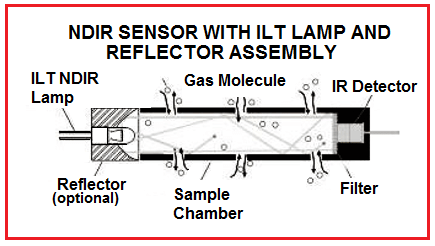Application & Technical Notes
Below is technical and application information on ILT's Subminiature T-¾ and T-1 NDIR lamps. Many of our lamps can be purchased right from our e-store. To speak with one of our lamp experts, inquire about a customized lamp, or to ask about a sample, contact us using the form below.
Most NDIR lamps can be customized for envelope size, burn-in, tolerances, MSCP, current and voltage.
Purchase an NDIR sample kit with 5 of our NDIR lamps
ILT Specializes in Producing Customized Light Sources for use in NDIR Gas Sensors

NDIR (Non-Dispersive Infrared) sensors are simple spectroscopic devices often used for gas analysis. The key components of an NDIR sensor are an infrared source (lamp), a sample chamber or light tube, a wavelength filter, and an infrared detector. The gas is pumped or diffuses into the sample chamber and gas concentration is measured electro-optically by its absorption of a specific wavelength in the infrared (IR).

The infrared light is directed through the NDIR sample chamber towards the detector. The detector has an optical filter in front of it that eliminates all light except the wavelength that the selected gas molecules can absorb. Other gas molecules do not absorb light at this wavelength, and do not affect the amount of light reaching the detector. The IR signal from the source lamp is usually chopped or modulated so that thermal background signals can be offset from the desired signal.
For greater optical efficiency, a reflector assembly can surround the lamp used for the NDIR sensor. The reflector is usually parabolic in shape to collimate the IR light through the sample chamber towards the detector. The use of a reflector can increase available light intensity by two to five times. The reflector surface can also be gold-coated to further enhance its efficiency in the infrared.
The intensity of infrared light that reaches the NDIR detector is inversely related to the concentration of target gas in the NDIR sample chamber . When the concentration in the chamber is zero, the detector will receive the full light intensity. As the concentration increases, the intensity of IR light striking the detector decreases. Beer's Law describes the exact relationship between IR light intensity and gas concentration:
Beer's Law:
I = I 0 e kP
where:
I = the intensity of light striking the NDIR detector
Io = the measured intensity of an empty NDIR sample chamber
k = a system dependent constant
P = the concentration of the gas to be measured
NDIR sensors can be used to measure practically all inorganic and organic gases, but are most often used for measuring carbon dioxide, because no other sensing method works as simply and reliably for this gas. Calibration gases of specific concentration are available for determining the NDIR system constant k for any particular sensor design.
Applications for NDIR Gas Sensors
- indoor air quality
- cycle regulation in self-cleaning ovens
- automotive and flue gas emissions
- greenhouse farming
- hazardous area warning signals
- gas leak detection
- landfill gas monitoring
- alcohol breathalyzers
- patient monitoring for anesthesiology / capnography
The NDIR gas sensor needs an infrared source for the excitation of the gas molecules. Thermal radiators such as ILT's Visible/IR lamps are often employed for this task. Their operating temperature should be as high as possible to obtain a large output intensity and detector signal. Glass envelope lamps operate at higher filament temperatures when compared to other filament or ceramic heating elements. The envelope can be a gas-filled or a vacuum. However, the transmission of the glass envelope limits the useful spectral range and constrains the types of gas molecules that can be measured by NDIR.
The transmission characteristics of a typical lamp glass are illustrated below together with the center wavelength of some common gas absorption bands. The intensity of the IR light decreases significantly above 4 mm with a cutoff wavelength located at 5 mm.
A Visible/IR lamp is a very cost-effective component for an NDIR sensor, but it has a limited IR range. For carbon dioxide (CO2) and hydrocarbon (HC) detection, it is an ideal technique.
The most desirable NDIR lamp characteristics are:
- high IR output
- accurate filament position
- small size
- long lifetime
- low thermal time constant
The last characteristic is important if the NDIR lamp power supply is to be modulated during operation to offset thermal background signals.
ILT Visible/IR lamps feature thin glass envelopes that reduce infrared absorption and provide more output in the infrared. Double-coiled filaments operate at high temperatures, and are rugged and geometrically precise for applications requiring broad spectral emission and superior optical performance.
ILT NDIR Gas Sensor Lamps are offered in T-1 and T-3/4 sizes with wire leads or bi-pin bases and operate at 5 volts. Several versions are available that operate from 45 mA to 150 mA with rated lifetimes from 5,000 to 100,000 hours.
ILT also offers a large line of reflector lamp assemblies with both fixed and adjustable focus options. Please contact the sales department at International Light Technologies to request more information.


